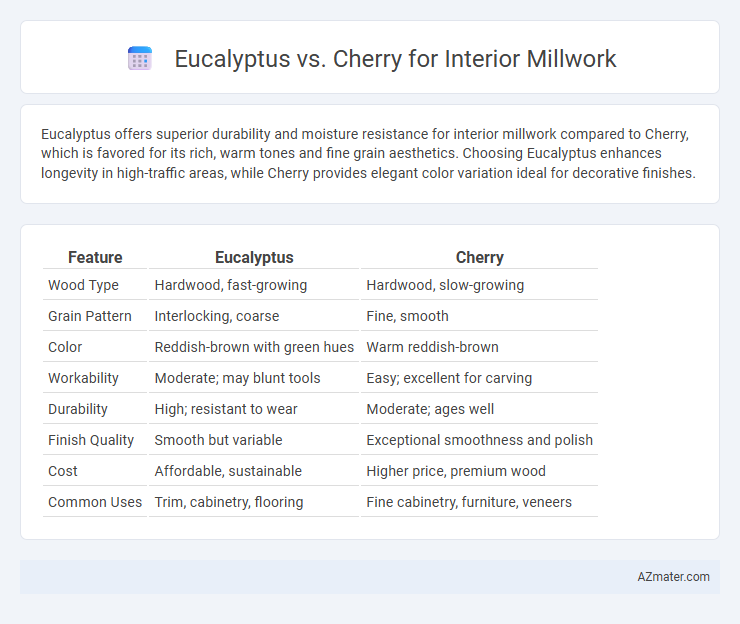Eucalyptus offers superior durability and moisture resistance for interior millwork compared to Cherry, which is favored for its rich, warm tones and fine grain aesthetics. Choosing Eucalyptus enhances longevity in high-traffic areas, while Cherry provides elegant color variation ideal for decorative finishes.
Table of Comparison
| Feature | Eucalyptus | Cherry |
|---|---|---|
| Wood Type | Hardwood, fast-growing | Hardwood, slow-growing |
| Grain Pattern | Interlocking, coarse | Fine, smooth |
| Color | Reddish-brown with green hues | Warm reddish-brown |
| Workability | Moderate; may blunt tools | Easy; excellent for carving |
| Durability | High; resistant to wear | Moderate; ages well |
| Finish Quality | Smooth but variable | Exceptional smoothness and polish |
| Cost | Affordable, sustainable | Higher price, premium wood |
| Common Uses | Trim, cabinetry, flooring | Fine cabinetry, furniture, veneers |
Introduction to Eucalyptus and Cherry Wood
Eucalyptus wood, known for its durability, fast growth, and sustainability, offers a dense grain and warm, reddish-brown color, making it ideal for interior millwork requiring strength and eco-friendliness. Cherry wood, prized for its rich, reddish-brown hue and smooth texture, develops a distinctive patina over time, adding elegance and warmth to millwork applications in high-end interiors. Both woods provide excellent workability, but eucalyptus stands out for its resistance to wear, while cherry is celebrated for its classic beauty and aging characteristics.
Botanical and Geographic Origins
Eucalyptus, originating from Australia, belongs to the Myrtaceae family and is prized for its durability and fine grain in interior millwork. Cherry wood, native to North America and part of the genus Prunus, is celebrated for its rich reddish-brown color and smooth texture. Both woods offer distinct botanical qualities and adaptabilities influenced by their unique geographic origins, making them suitable for various interior design applications.
Appearance: Color, Grain, and Texture
Eucalyptus features a rich, warm tone with reddish-brown hues and a smooth, consistent grain that often includes subtle swirling patterns, adding depth and character to interior millwork. Cherry wood is known for its fine, straight grain and its luxurious reddish-brown color that deepens and darkens over time, creating a rich patina that enhances cabinetry and millwork. The texture of eucalyptus is generally smooth with a slight natural luster, while cherry offers a silky, closed-grain surface that takes stain and finish exceptionally well for refined, elegant interiors.
Durability and Strength Comparison
Eucalyptus wood exhibits superior durability and strength compared to cherry, making it an excellent choice for interior millwork subjected to heavy use or wear. Eucalyptus has a higher Janka hardness rating, typically around 1,380 lbf, whereas cherry rates about 950 lbf, indicating greater resistance to dents and scratches. The dense grain structure of eucalyptus also enhances its stability and longevity, outperforming cherry in environments prone to moisture or temperature fluctuations.
Workability: Cutting, Sanding, and Finishing
Eucalyptus wood offers excellent workability for interior millwork, characterized by its moderate density that allows smooth cutting and minimal tool wear. Sanding eucalyptus yields a fine, even surface, enhancing its natural grain appearance which responds well to oils, stains, and varnishes for a durable finish. Cherry wood, favored for its fine grain and moderate hardness, sands easily to a silky smooth texture and finishes beautifully, developing a rich patina over time that highlights its reddish-brown hues.
Cost and Availability in the Market
Eucalyptus offers a cost-effective option for interior millwork due to its rapid growth and widespread availability, especially in regions like Australia and the southern United States, making it a budget-friendly choice for large projects. Cherry wood, known for its rich color and fine grain, commands a higher price and can be harder to source consistently, particularly from sustainable sources, resulting in increased costs and longer lead times. Market availability favors eucalyptus for volume-driven projects, whereas cherry is preferred for premium finishes where budget allows.
Sustainability and Environmental Impact
Eucalyptus and cherry wood present distinct sustainability profiles for interior millwork, with eucalyptus recognized for its rapid growth rate and efficient carbon sequestration, making it a highly renewable resource. Cherry, sourced primarily from slower-growing hardwood forests, often involves longer harvesting cycles, resulting in a higher environmental footprint due to extended regeneration periods. The eco-friendly advantages of eucalyptus include lower water usage and minimal pesticide requirement, whereas cherry wood's impact is amplified by deforestation concerns and habitat disruption in certain regions.
Suitability for Interior Millwork Applications
Eucalyptus offers a dense, durable structure with natural resistance to moisture and insects, making it highly suitable for interior millwork applications requiring longevity and stability. Cherry wood provides a fine, straight grain with a smooth texture and rich, warm tones that enhance aesthetic appeal in decorative millwork and cabinetry. Both woods are workable, but eucalyptus excels in structural elements, while cherry is preferred for detailed finishes and elegant interiors.
Maintenance and Longevity
Eucalyptus wood offers moderate durability and requires regular sealing to prevent moisture damage, making maintenance more frequent compared to cherry wood. Cherry wood boasts excellent longevity with a natural resistance to wear and minimal upkeep, as its tight grain reduces susceptibility to scratches and dents. Choosing cherry for interior millwork ensures a long-lasting, low-maintenance finish ideal for high-traffic areas, while eucalyptus may be suited for spaces where budget constraints prioritize initial cost over extended durability.
Choosing the Right Wood: Eucalyptus vs Cherry
Eucalyptus offers exceptional durability and moisture resistance, making it ideal for high-traffic interior millwork, while Cherry provides rich color and smooth grain that enhances aesthetic appeal in fine cabinetry and trim. Eucalyptus matures quickly and is more sustainable, offering a cost-effective option compared to the premium, slow-growing Cherry wood known for its warm, reddish hue. Selecting between Eucalyptus and Cherry hinges on balancing environmental factors, budget considerations, and desired visual impact for your specific interior millwork project.

Infographic: Eucalyptus vs Cherry for Interior Millwork
 azmater.com
azmater.com